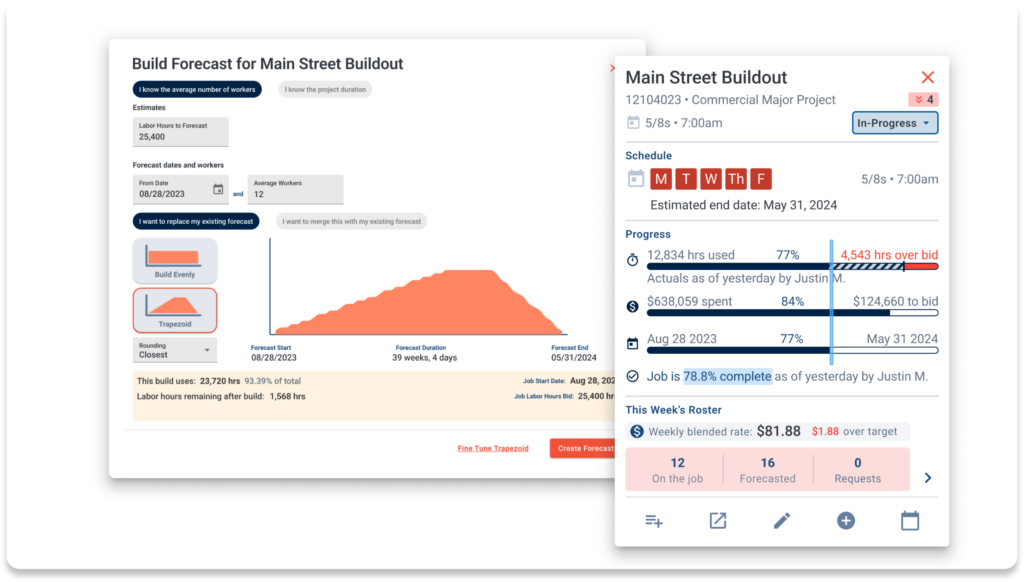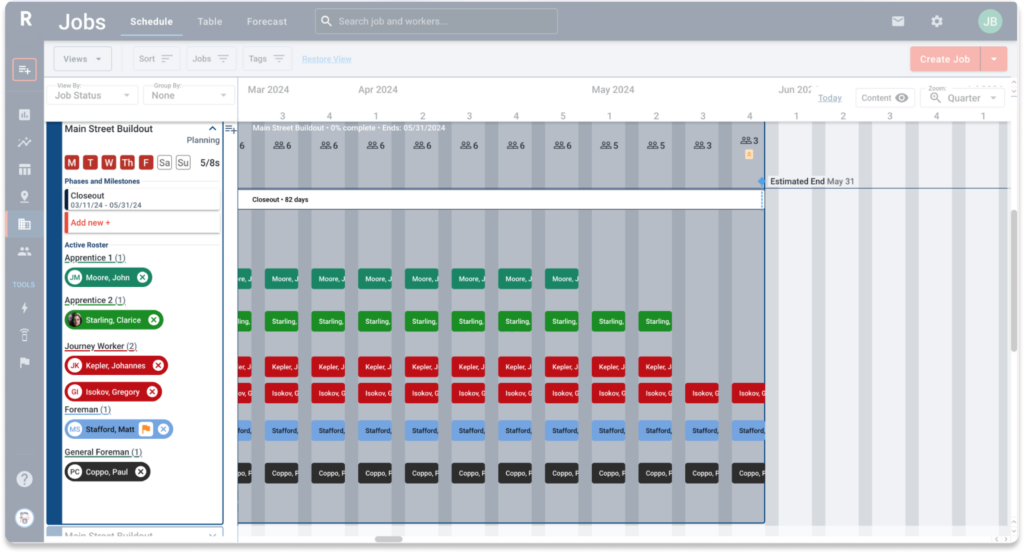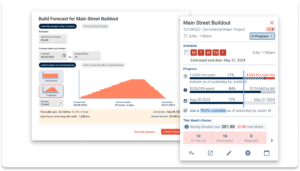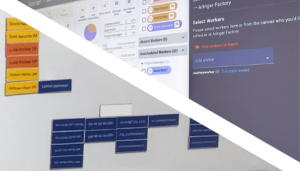MEP Contractor Executives
Are you losing profit in the last 20% of your projects?
When a construction project blows up, it becomes apparent at the labor peak

Gary Fuchs is RIVET’s Sr. Workforce Management Advisor. Gary spent 40+ years at Westphal & Company Inc. proving out expert practices for workforce management and labor planning. He later joined LaborChart, acquired by Procore, where he advised contractors across the globe on these practices. We sat down with Gary to do a deep dive on the labor peak.
Start today.
Adopting the RIVET Workforce Management Platform can have a huge impact on your field performance and profitability.
Do you know when your labor is peaking on every project? Do your project teams and field leaders know as well?
Knowing your labor peak is a strong indicator of success or failure — and a gauge of profitability.
It means you’re aware of your labor curve, and that you have a good labor plan for tracking to that point against your labor budget and project timeline. You know that, at your peak, it’s time to reduce the number of people on that job.
The impact of the labor peak on your business
There is a common opinion that “construction is hard.” And it is hard. Everyone shares in the pain, and that’s the norm.
If your projects are lacking a labor plan, you’re unaware of the peak, and your projects are lacking an exit strategy, the impact might look like this:
- The job loses a bunch of money without transparency into how labor is managed. “I guess construction is hard with no other explanation.”
- Superintendents and project managers have no idea they screwed up and will blame the estimator.
- Everyone is working really hard, but no one has any idea what’s causing the overages.
A well-executed Workforce Management strategy can put checks and balances in place that help identify the problems as they arise. With that kind of clarity, you can pinpoint when project extensions have nothing to do with you, and instead are an issue driven by the general contractor.
“You’re able to show the problems are driven by external forces,” Gary said. “You can take a proactive approach to getting work done. When you’re doing that, there is work available for you and you’re working at a highly efficient level. The general contractor will hate you at the moment but love you in the end. You become the subcontractor they want because they don’t have to babysit you.”
Productivity and the labor peak
Fast-forward to a job site in progress. You’ve just reached 80% complete. Gary says this is where the project is vulnerable and the discussions you have will determine success or failure. Are you going to keep your projected profit or experience the dreaded margin fade phenomena?
“This is where you go, ‘oh shit’, we’ve got a problem, and it’s too late,” Gary said. “You’ve created a disaster, and now you’re in the last 20% of the job, and you think you’re a lot farther ahead and the deadline hasn’t moved. Now what? You have no choice. You must add labor. Now you’re walking the plank. You must bring another supervisor and crew, they need to learn the job site, this is a big learning curve. Not only are you pumping people into this job, but they also aren’t 100% productive when show up. Now you’re throwing money at it because you have to get it done. Tools, equipment, labor, safety supervision. Everyone is pulling their hair out? asking what the hell happening. The easy out is blaming it on a bad estimate. This is typically simply not the truth. There is a lack of awareness that the labor was mismanaged or the people responsible for the poor discussions aren’t going to step up. It’s easier to blame the estimate.”

How can you set up your project teams for success?
By having a labor curve for every project, your teams will be monitoring your labor up to the peak. This allows them to focus on controlling your labor budget prior to peak. When the peak arises, they need to know it’s time to reduce the number of people on that job. But how can you do that with a lot the work still available? Sure, they could keep their crews for an extended period. But why wouldn’t you do that?
When your project teams get to the peak, they need a punch list:
1. Make a detailed list (punch list) of what still needs to be done.
2. Assign labor hours next to every line item.
Make sure that assessment accurately accounts for logistics to complete tasks, not just the tasks themselves.
3. Determine the total number of labor hours needed.
Compare this to your budget to have a clear understanding of where you are and what you have left. You may find you already have a problem if your ramp up labor plan wasn’t well defined to begin with, and you weren’t monitoring your labor curve.
4. Set goals to get the work done in an orderly fashion.
“Stick to the plan and finish the job. Your foremen will be astonished by this approach. By being proactive, the owner-generated punch list should be minimal. Most loose ends are cleaned up allowing for a clean and orderly closeout.” Gary said.
Good labor planning requires a good tool
Obviously, Gary would recommend MEP contractors use the RIVET Workforce Management Platform for labor planning. But you need to be ready to use it properly.
With RIVET, you are now managing your labor in real time, with controlled transparency for everyone to see, which turns into a very high level of collaboration.
”There is no other way to monitor your labor in real time other than a platform like RIVET,” Gary said. “Contractors ask me, what do you mean real time? Do you mean within a day? Real time is real time, within a second. You get to be so proactive at managing your labor and you start to wonder what you would ever do without it. If you took RIVET away from the contractors that use it, they would struggle and most likely crumble. It’s becomes so engrained in the workflow processes that it’s hard to manage without it., Moreover, if you integrate it with your financials, it’s an indispensable tool.”
Get Started Today
Construction labor challenges can be greatly reduced with the right software


